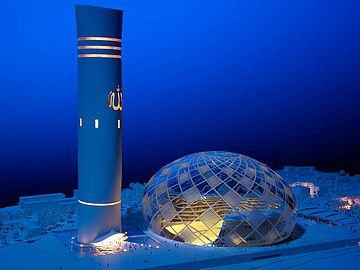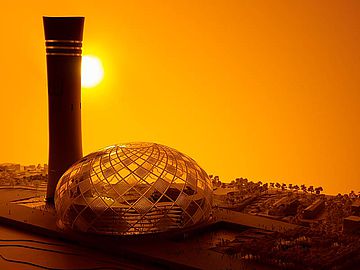Touching the sky
Mosque, Algeria
In the next few years the largest Mosque in the world after Mekka and Medina with space for over 100,000 believers will be built in the capital city of Algeria. The competition design from Gerd Priebe Architects and consultants is a multi levelled plateau ensemble that is both integrated and in harmony with the existing city architecture and topographical context. The imposing glass dome of the Mosque and the elegant high climbing minaret of the ensemble can be seen from afar lying between the old city and the Mediterranean Sea.

Being situated on the south bank of the Mediterranean Sea and due to its long and rich history, which also includes the roughly 130 years of French rule that first ended in 1962, the Algerian capital city Algiers has functioned as the most important hinge between European and Arabic culture over hundreds of years. A plethora of superb buildings demonstrate the meaning of the title “the white city on the sea” – among them the Great Mosque from the 11th century and the Mosque „Djamâa el Djedid“, finished in 1660, both of which can be found in the old City of Kasbah, listed under Unesco World Culture Heritage.
The design for the Grand Mosque which is meant to be built within the next few years between the old city in the south and the Mediterranean harbour, neighbouring just a few hundred metres further in the north, rises even higher than both the historical precedents. The world’s 3rd largest Islamic House of Prayer will have cost approximately 2ooo Million Euros when accomplished. Only the Mosque of Mekka and Medina, the two holy Sites of Islam, are larger. A total of 17 participants from 11 nations were selected to take part in the international competition.

Plateau over the city
In order to integrate the 2 ha site well into the impressive city planning and the topographical context the designers developed an elongated plateau that appears to grow naturally out of the city landscape. It is as if it grew with it and was with great care sculptured. Like a row of pearls the greater part of the Mosque’s various functions is integrated into the plateau. The far to be seen minaret forms the beginning towards southeast, hosting inside a museum of ancient history, a centre for culture and restaurants and a shopping area.
Directly adjacent the minaret is the imposing Mosque with its 9 galleries and levels which provides space for a total of 65,000 believers to pray under the powerful dome.

Further in direction northwest one finds the 100 x 100 meter large Esplanade with a mezzanine level for 12,000 men and 8,000 women. Behind the hall of columns lies with a welcome centre and the garden of paradise with the Qur'anic school for 320 students. The functions mentioned are both framed and contained through the higher lying plateau with a beautiful view over the city where there is space for 45,000 people.
The other functions of the complex are positioned outside the plateau area. Among them the private boarding school formed by four separate squares set together and the two dining halls together with the administration building. Further east at the foot of the Mosque the houses of the Imam lie with their fine proportioned tensile covered structure similar to a tent. On top of these there are further representative, reception and work rooms for the Imam together with two apartments for special guests. Below the plateau there is also an underground car park with a total of 10,000 parking spaces on 7 levels. The traffic connection to the entire complex is from the underground coastal highway to avoid noise and to optimize the traffic flow.

Bridging Tradition and Modernity
As a present day answer to the centuries old building challenge „Mosque“ the design takes a conscious decision to move between the modern and the traditional interpretations of the Arabic-Maghrebinian architecture. “The geometrical motive of the square played a decisive role as well as the number 5, a most important number in Islamic culture, which served as the most important order and design number figure right down to the smallest detail of our design” explains architect Gerd Priebe. “That reflects itself immediately in the general order and in the inner structure of the individual elements for which we have used the strong geometrical design principle ‘five multiplied by five squares’.
Impressive examples for the rhythm of organized space are the esplanade and the paradise garden with the Qur'anic school. Also the space of the column hall was consequently divided into 5 x 5 areas. The edges of the resulting 25 fields are limited with small columns which together create a fascinating spatial experience. The halls extrude a universal clarity and geometrical order which calls directly to the visitor’s mind the famous “La Mezquita” in Córdoba with its 1000 columns of jasper, onyx, marble and granite.

Imposing Impression of Space
An interesting variation of this five multiplied by five square can be seen in the Mosque’s high climbing dome of emerald coloured glass. As an example of a modern interpretation of the historical principle “Circle in Square” the architects created an outer circle which encloses an area of single squares in mathematical rhythms. The inner space of Gerd Priebe’s Mosque design is provided with organically formed galleries, which climb upwards left and right over nine stories, from level to level reducing in size in correspondence with the outer walls.
A diffuse daylight falls through the prominent glass dome and creates a soft green tone in the space. A special moment to observe is the artistically designed graphic patterns that are to found on the surface of the glass dome. The artistically designed structures express not only the movement of light and the play of shadow in the inner world of the praying room but at the same time contain a solar network membrane which supports the energy system for the entire complex. As a further ecological component the new construction uses the Mediterranean Sea for heating and cooling.

Multifunctional Minaret
Directly beside the Mosque the minaret which is surrounded by a water pool towers into the sky with its sculptured surface. The 52 story high structure, built with high quality materials and served by an express lift, incorporates different functions – among them a Bistro, a shopping area and an oval shaped multimedia center with lecture halls that stretches over several floors. The central technical plant with uncountable controlling systems is situated on the 44th floor. For the optimal security of the complex there are also earthquake sensors and a preventive fire protection system.
A further function which is planned in the minaret is the museum for ancient history with 18 goblet shaped overlapping levels. The valuable exhibits are protected from the ultra violet sunlight beams through “Light wave conductors” which are optical fibres placed into the concrete. This construction allows also light and colour to be seen through the concrete forms. The visit to the visitor platform is the crowning moment on the visitor’s program. The platform, situated 235 metres high in the sky, offers a dreamlike view over the Mediterranean Sea harbour and the whole complex of the Mosque.

Use
Mosque, museum, exhibitions, multifunctional rooms, restaurant, shopping, Qur'anic school and private boarding school, administration
Award of contract
Competition
Services Provided
Mosque, museum, exhibitions, multifunctional rooms, restaurant, shopping, Qur'anic school and private boarding school, administration
